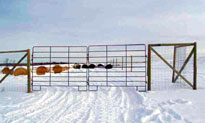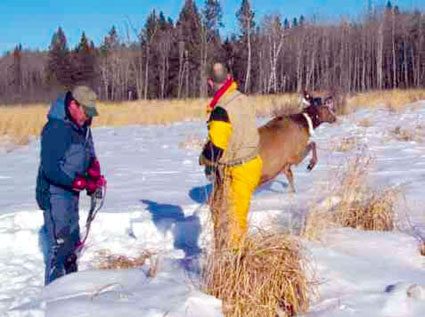page4
Achieving bovine Tuberculosis-free status in domestic cattle and park wildlife
Manitoba Bovine Tuberculosis Management Program recognized as excellent model for other animal disease control efforts
The rolling hills and valleys of Riding Mountain National Park of Canada appear above the surrounding plain as a bluish other-world dominating the horizon. Forming part of the Manitoba Escarpment, this "island" reserve protects a wide variety of wildlife and vegetation areas. It is also home to a population of free-roaming elk (Cervus elaphus manitobensis) that is infected with Mycobacterium bovis, the agent of bovine tuberculosis (Tuberculosis). The disease has also appeared in a number of cattle herds and in deer near the park.
Bovine tuberculosis is a serious infectious disease affecting cattle, sheep, goats, bison, members of the deer family and many other species. It is suspected that the disease has been transmitted between elk, deer and cattle when wildlife feeds from the hay bales put out for cattle to eat in the winter. TB can have a devastating impact on the cattle industry. Following three separate outbreaks of Tuberculosis in eight cattle herds surrounding the park, Parks Canada joined other government agencies, community leaders and wildlife and agricultural representatives to reduce the spread of Tuberculosis in wild and domestic animals.
Beginning in 2000, the Task Group for Bovine Tuberculosis quickly mounted a concerted, collaborative and multi-faceted management program that is already proving effective in disease control and prevention. The Task Group includes the Canadian Food Inspection Agency, Manitoba Agriculture and Food, Parks Canada and Manitoba Conservation, along with the Manitoba Cattle Producers Association and Manitoba Wildlife Federation.
 Hay in an enclosure © Parks Canada / K. Kingdon |
Park staff and their partners are working to ensure that, while the disease is being fought, it does not have a negative impact on the park's ecological integrity. Experience gained from the Manitoba Bovine Tuberculosis Management Program regarding multi-agency cooperation, wide public consultation and an integrated response to disease management can be directly applied to other disease-control efforts. It has also strengthened partnerships among park staff, local landowners, rural municipalities, First Nations and other stakeholders who will benefit from Riding Mountain National Park in the future.
Results
- To date, 313 elk have been live-captured and tested. Of these, 122 animals have been removed as suspect bovine TB cases. A total of 2,550 elk and 3,200 deer from hunter-killed animals have also been tested for TB. It is estimated that 9% of the elk population is infected with TB. The numbers are lower in deer and the disease has also been found in wolves and coyotes.
- The Canadian Food Inspection Agency provides enhanced testing of cattle and other domestic livestock surrounding the park. Roughly 55,000 breeding cattle on 650 premises make up the designated Riding Mountain TB Eradication Area, representing 10% of Manitoba's cattle herds and 1% of all Canadian cattle herds.
- To prevent contact between cattle and elk, over 100 eight-foot-high wire barrier fences have been erected around 95% of the hay storage yards within three kilometres of the park. This effort, which was supported by the Province of Manitoba and Parks Canada, with the help of local First Nations contractors, has shut down a primary disease transmission route.
- Hunting seasons in the two game hunting areas surrounding the park have been extended. As well, more hunting permits have been made available by Manitoba Conservation. The Manitoba Wildlife Act was also changed to make the baiting of elk outside the park illegal.
- Provisions to protect wolves were enacted, given that they are the main predators of elk in the park.
- A total of 202 elk have been captured and radio-collared, resulting in 33,000 geo-referenced locations of elk movements that will provide a model for the potential spread of disease.
- Prescribed forest burns have improved elk forage habitat within the park and encourage elk to remain within park boundaries during the winter when food is limited.
- Local First Nations technicians have been hired and trained to collect and examine tissues to sample from hunter-harvested animals at the new regional wildlife health laboratory and provincial centre established for diagnosing chronic wasting disease and bovine TB in Manitoba.
- The Task Group for Bovine Tuberculosis received the 2004 Manitoba Federal Council's Exceptional Contribution Award for cooperative management of bovine TB in Riding Mountain National Park.
 Elk running away in the snow © Parks Canada / D. Macarthur |
- Date modified :